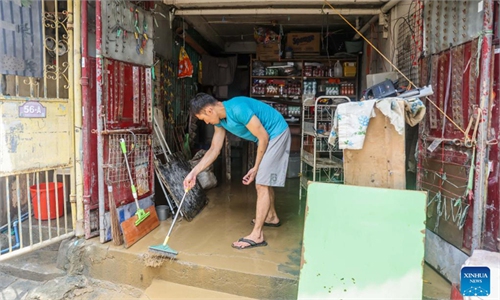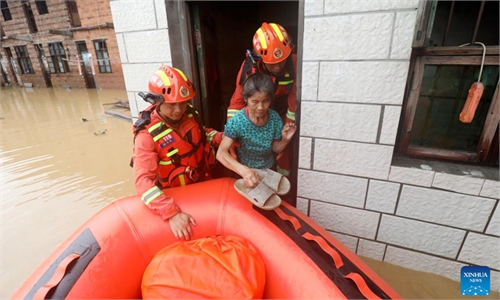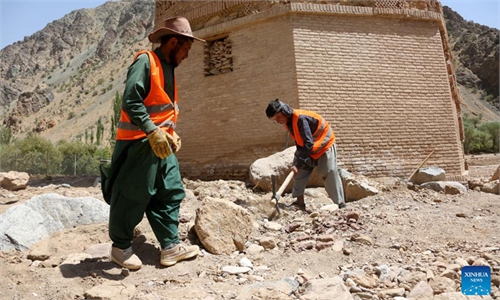Rescue efforts in full swing as embankment breaches in C.China’s Hunan
Wing Loong drones dispatched to provide phone signals

Villagers have lunch at a resettlement site in Xiangtan county, Central China's Hunan Province, on July 29, 2024. More than 3,800 people in the area were safely relocated after breaches occurred in the embankment of a tributary of the Xiangjiang River in Hunan Province in Typhoon Gaemi's wake. Photo: VCG
Rescue efforts are in full swing as at least three breaches have appeared in the embankment of a tributary of the Xiangjiang River in Central China's Hunan Province, leaving swathes of land soaked in water in Typhoon Gaemi's wake. About 4,600 local residents have been relocated, with no casualties reported so far.
At around 13:40 on Sunday, a third breach, over 30 meters in length, occurred in the embankment section of Huazhong Village in Hekou township, Xiangtan.
The other main breach occurred in the Sixin dike of Yisuhe township in Xiangtan. By 9:40 pm Sunday, the breach had expanded to 50 meters wide and by 3:58 am Monday, the breach had expanded to 77 meters wide.
As of press time, the width of the breach in the Sixin dike has not changed much, and the water levels inside and outside the embankment have been stable, with the flow rate slowing down. More than 3,832 people in the area have been evacuated, with no casualties reported.
"The flood water just entered my house and continued to rise on Sunday night. Everything was soaked in water. Until the local rescue teams came, we were told to leave by taking life boats," Xiao Hao, a local resident from Yisuhe township in Xiangtan, told the Global Times on Monday.
According to media reports, local fire rescue forces have been dispatched to Yisuhe. At around 2 am on Monday, firefighters were carrying lifeboats and advancing toward the disaster area with difficulty due to the narrow roads. Large groups of people have already been transferred to safe places by lifeboats, media reports said.
Forces from emergency management have also dispatched 200 professional rescue personnel and 110 units of professional equipment, with the first team consisting of 70 personnel and 15 pieces of equipment. They have been transferred from the landslide site in Yuelin village, Hengyang, to Xiangtan and have arrived at the breach site to carry out their work.
At the rescue site conducting emergency rescue operations at the Sixin dike in Yisuhe town, over 600 officers and soldiers from the Hunan military, 200 officers and soldiers from the Hunan Armed Police, more than 200 professional rescue personnel from China Anneng Construction Group, 30 individuals from China Railway, and members of the Blue Sky Rescue Team and local rescue teams were involved in rescue efforts.
In addition, the working group of the State Council for Disaster Prevention rushed to Yisuhe town overnight.
Previously, another breach of about 10 meters had appeared in the embankment in Liushuwai, Xiangtan's Longtan village, around 18:40 on Sunday. As of press time, the repairs had been completed, and the accumulated water inside the embankment had been nearly drained.
The water levels at the local hydrological station have returned to normal. After the completion of disinfection in the flooded areas of Longtan village and Heping village, affected residents are now returning to their homes.
As of press time, due to the impact of rainfall, 97 rivers in Heilongjiang, Jilin, Liaoning, Hunan, Guangdong, Yunnan, Sichuan, Xinjiang and other places have experienced water exceeding warning levels, according to the Ministry of Water Resources..
Among them, 40 rivers have experienced water exceeding flood control levels.
A live-stream video posted on Douyin, the Chinese version of TikTok, on Monday showed that swatches of land and houses were flooded.
In Chenzhou, another city in Hunan, many townships in Zixing city have been hit by heavy rainstorms, with some stations recording rainfall exceeding historical records the province starting from July 26.
Currently, eight out of the 10 villages in Bamianshan township remain out of contact. Early Monday, 10 rescue teams entered the isolated villages on foot to investigate the disaster situation and help evacuate trapped residents.
Apart from allocating local rescue forces, according to the emergency management department of Chenzhou, three helicopters were dispatched to Bamianshan township and other areas where transportation was blocked due to heavy rain to deliver food and essential supplies. The helicopters were loaded with water, rice, instant noodles, vegetables, oil and other daily necessities, which can meet the needs of 13,200 people.
The local authorities have also prepared charged power devices and essential medicines to meet urgent communication and medical needs. China's domestically developed Wing Loong drones took off from East China's Fujian early Monday and will provide mobile phone signals to areas with damaged communication facilities through an aerial communication platform.
Meteorological experts say that the cloud system of Typhoon Gaemi combined with the southwest monsoon resulted in very strong water vapor development in the high-humidity areas of Hunan, leading to the appearance of a strong rainfall center in the Hunan region.
Ma Jun, director of the Beijing-based Institute of Public and Environmental Affairs, told the Global Times on Monday that the process of flood evolution and the subsequent affected areas need to be further studied using a hydrodynamic model.
The construction or raising of levees at appropriate locations downstream of breaches should be implemented to prevent floods from continuing to spread and prevent the further expansion of the disaster, Ma said. He noted that the ongoing rainfall increased the difficulty in responding to disasters.



